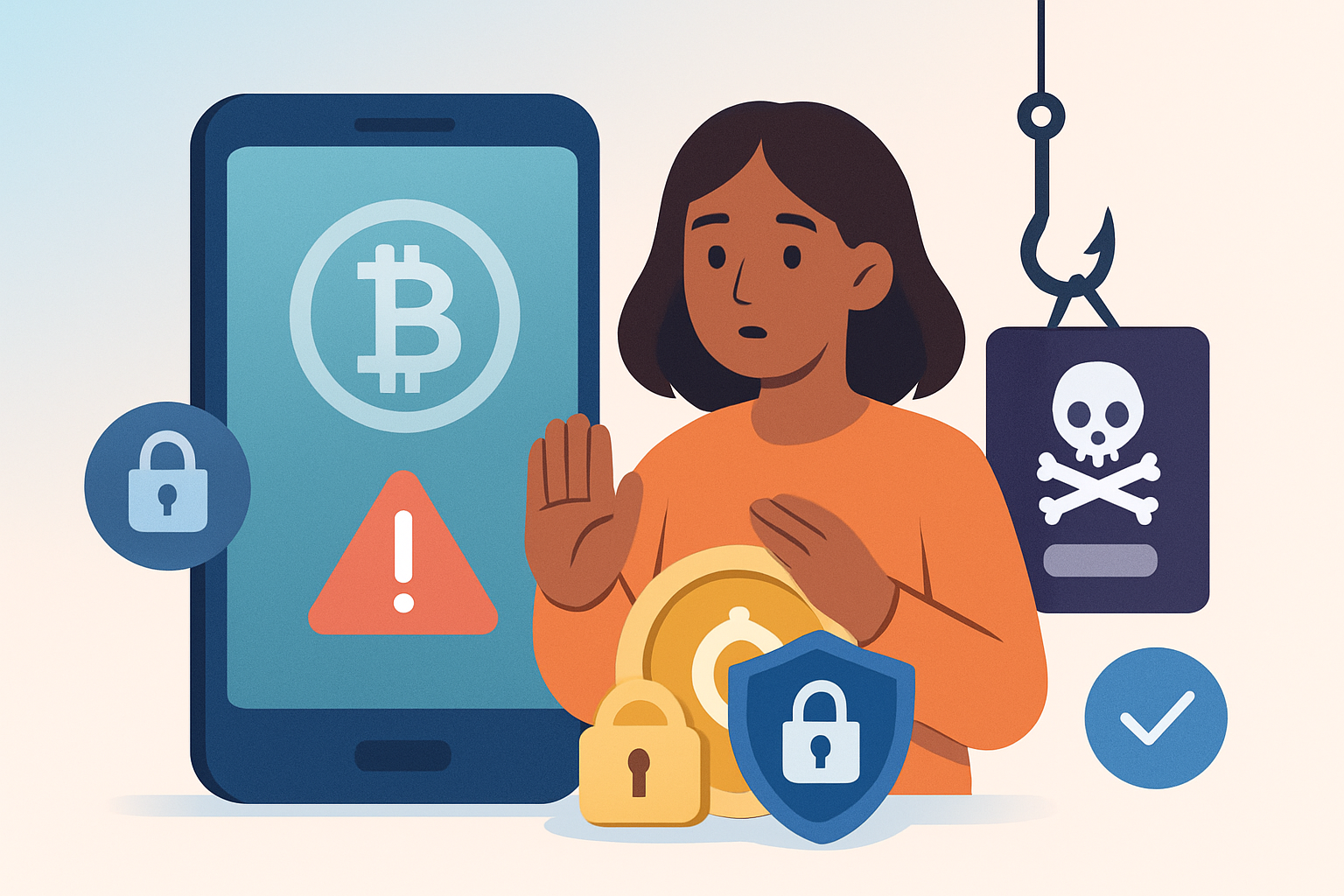Crypto investors faced a harsh reality in August 2025: phishing scams surged to record levels, draining over $12 million from more than 15,000 wallets. According to data from multiple security platforms, this marks a staggering 72% jump in losses compared to July. The spike is not just a number on a chart, it’s a wake-up call for anyone onboarding into crypto or managing digital assets.

Why Are Crypto Phishing Scams Surging in 2025?
The sophistication of crypto phishing scams has evolved rapidly. Attackers now leverage fake websites, social media impersonation, and even exploit new blockchain features to trick users out of their funds. EIP-7702 signature scams are at the center of recent headlines, with one investor losing $350,000, including WETH, WBTC, and NFTs, by unknowingly signing a malicious transaction on a counterfeit site. In three major attacks alone, over $5.6 million vanished due to this exploit (Binance).
The common thread? Scammers are adept at mimicking trusted brands and platforms, often using urgent messages or exclusive offers as bait. Whether it’s an email from what looks like your favorite exchange or a direct message from a supposed NFT project founder on Discord, these tactics prey on both new and seasoned users alike.
The Anatomy of Modern Crypto Phishing Attacks
Let’s break down the most prevalent attack vectors seen in August:
Top Crypto Phishing Scam Tactics in August 2025
-

EIP-7702 Signature Scams: Attackers exploited Ethereum’s new smart contract wallet feature, EIP-7702, tricking users into signing malicious transactions that drained wallets. Over $5.6 million was stolen in just three attacks. Always verify every signature request in your wallet.
-

Fake Crypto Websites and Login Pages: Scammers created counterfeit versions of popular platforms like MetaMask, Binance, and Coinbase to steal user credentials and private keys. Check URLs carefully and use bookmarks for official sites.
-

Social Media Impersonation: Fraudsters posed as trusted figures or companies on X (formerly Twitter), Telegram, and Discord to promote fake giveaways or investment opportunities, luring users to phishing sites.
-

Malicious Links and Attachments: Unsolicited emails or DMs contained links or files that, when clicked, installed malware or redirected users to phishing pages. Never click suspicious links or download unknown attachments.
-

Fake Customer Support Scams: Attackers impersonated support staff from major exchanges and wallets, asking users for sensitive information or to “verify” their accounts, leading to stolen funds.
-

Batch Approval Phishing Attacks: Victims were tricked into granting broad token approvals via phishing sites, allowing scammers to drain entire wallets in a single transaction, especially with new token standards like EIP-7702.
- Fake Websites and Emails: Nearly indistinguishable from official platforms. Even experienced users can be tricked into entering private keys or seed phrases.
- Discord and Social Media Impersonation: Fraudsters pose as NFT projects or influencers, offering fake giveaways that require wallet connection.
- Malicious Links and Attachments: Clicking these can install malware or redirect you to phishing portals designed to empty your wallet.
- EIP-7702 Exploits: Attackers send batch approval requests that look routine but grant them sweeping access to your assets if signed blindly.
This isn’t just theoretical risk, it’s happening daily. One user lost over $3 million in a single incident after clicking through an urgent Telegram message that led to a fake DeFi platform login page (Cointelegraph). The scale and speed of these attacks demand vigilance at every step.
Your First Line of Defense: Smart Onboarding and Daily Security Habits
If you’re new to crypto, or even if you’re not, protecting your funds starts with robust onboarding practices and ongoing awareness. Here are actionable tips proven effective against the latest wave of threats:
- Always verify website URLs before entering credentials.
- Bookmark official exchange and wallet sites; avoid clicking links from emails or DMs.
- Enable two-factor authentication (2FA) everywhere possible.
- Consider using hardware wallets for storing significant assets offline.
The most important habit? Never rush into signing any transaction, especially if prompted by unexpected messages or time-sensitive offers. Double-check every detail before approving anything in your wallet interface (Blockchain Council). Education remains your best shield against evolving threats.
But what if you’ve already clicked something suspicious, or worry your wallet has been compromised? Acting quickly is essential. Immediately disconnect your wallet from all dApps, move your funds to a new secure address using a hardware wallet if possible, and update all security settings on related accounts. If you suspect malware, run a full antivirus scan and consider seeking help from reputable cybersecurity experts familiar with crypto.
Understanding EIP-7702 Exploits and How to Stay Safe
The EIP-7702 exploit is particularly concerning because it manipulates Ethereum’s smart contract wallet features. Attackers craft batch approval signature requests that appear routine but actually give them sweeping permissions to move assets, including NFTs and tokens, without further confirmation. The key takeaway: never sign a transaction or approval you don’t fully understand. If you’re prompted to sign something labeled as “batch approval” or “permit, ” pause and verify its source.
Wallets like MetaMask are working on better warnings for risky transactions, but the ultimate responsibility still lies with users. Regularly review your wallet’s connected sites and revoke permissions you no longer use. If in doubt, seek guidance from trusted crypto communities or support channels before signing anything unfamiliar.
Community Vigilance: Why Sharing Knowledge Matters
The surge in crypto phishing scams 2025 isn’t just a technical issue, it’s a community challenge. Scammers often recycle tactics across Discord servers, NFT drops, and Telegram groups. By sharing experiences and warning others about new threats, the community becomes more resilient.
If you spot a suspicious link or encounter a scam attempt, report it immediately on the platform where it appeared. Many projects now have dedicated security channels specifically for user reports. Participating in these efforts not only helps others but also strengthens your own awareness of emerging risks.
Quick Checklist: Protecting Your Crypto Funds in 2025
If you’re onboarding friends or family into crypto, walk them through basic security steps, bookmarking official sites, enabling 2FA, using strong passwords, and practicing healthy skepticism toward unsolicited messages. Remind them that legitimate teams will never ask for private keys or seed phrases via DM or email.
Stay Ahead: Resources for Ongoing Security Education
- Blockchain Council: How to Avoid Crypto Scams
- Binance: Protect Your Crypto from DeFi Phishing Scams
- Cointelegraph: Phishing Scams Cost Users $12M in August
The reality is harsh, over $12 million lost in August alone, but it isn’t hopeless. Each new scam is an opportunity to learn faster than the attackers adapt. With vigilance, practical onboarding routines, and community support, you can protect your digital assets even as threats evolve.

